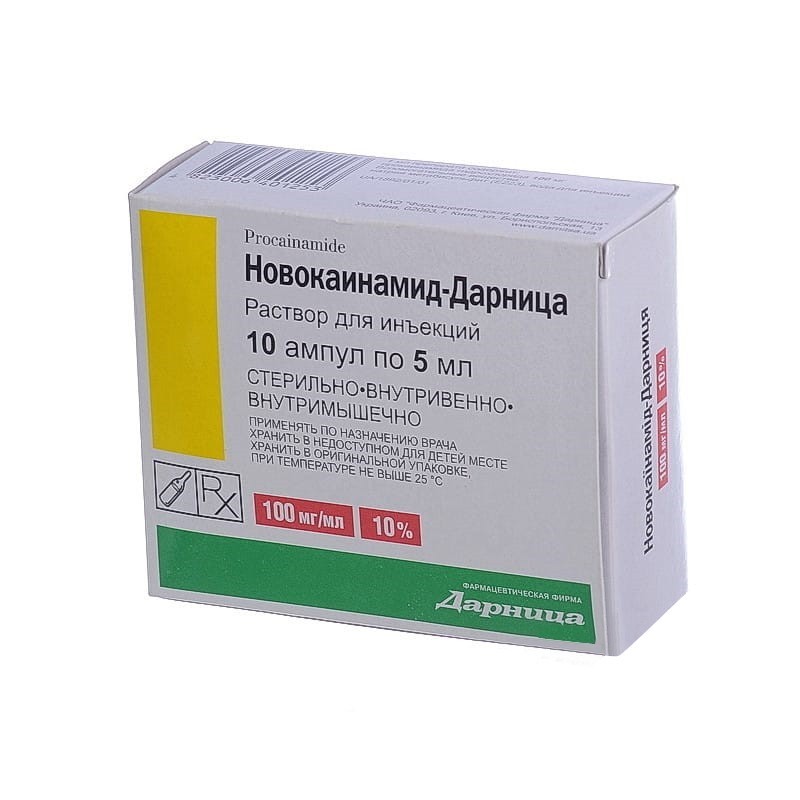



 Secure and encrypted payment processing
Secure and encrypted payment processing We ship to over 40 countries including the USA, UK, Europe, Australia and Japan
We ship to over 40 countries including the USA, UK, Europe, Australia and Japan Guaranteed refund or reship if you haven't received your order
Guaranteed refund or reship if you haven't received your orderProcainamide (beta-diethylaminoethylamide para-aminobenzoic acid hydrochloride) is an antiarrhythmic agent. Novocaineamide, like quinidine, contains a tertiary amide group in the molecule, which determines the mechanism of its membrane-depressant action. lengthens the effective refractory period more than the action potential in the atria and ventricles. slows down conduction in the atria, atrioventricular node and ventricles, inhibits the excitability and, to a small extent, the contractility of the myocardium. It has a vasodilating effect, causing arterial hypotension. blocks parasympathetic reactions (anticholinergic effect).
After oral administration, it is absorbed in the stomach after 15-30 minutes, the maximum concentration in the blood plasma is reached after 1 hour.
With the on / in the introduction and the concentration in the blood plasma of 2-4 mg / l, the drug begins to have some antiarrhythmic effect, 4-10 mg / l is effective, above 8 mg / l is toxic. At a therapeutic concentration of about 15%, Novocaineamide-Darnitsa binds to macromolecular plasma compounds. Relatively little hydrolyzed by plasma esterases. In most tissues, except the brain, the concentration of Novokainamid-Darnitsa is higher than in blood plasma. With the on / in the introduction after 1-1.5 hours, the maximum level of the drug in the blood decreases by 50%. The concentration curve of the drug with this route of administration has 2 phases: fast (average constant - 6.4 minutes, half-life - 4.4 minutes), due to the rapid release of the drug into the blood, and slow, independent of its concentration in the blood (average constant - 5.1 hours, half-life - 3.5 hours). It is biotransformed in the liver with the formation of N-acetylNovocaineamide (with slow acetylation - only 7-12%, with fast - about 23%). N-acetylNovocaineamide acts like Novocaineamide, causing an antiarrhythmic effect.
It is excreted by the kidneys by glomerular filtration and tubular secretion; 50-60% - unchanged. About 15% of the dose taken appears in the urine as N-acetylNovocaineamide; 2-10% - as PABA. The elimination half-life of Novokainamid-Darnitsa is 3-4 hours, and its acetyl-regulated form is about 4 hours. Usually, the drug does not cumulate in the body, but in patients with heart and kidney failure its excretion is slowed down and prolonged use may result in cumulation. In renal failure, the elimination half-life is extended to 7–17 hours (for an acetylated preparation, up to 40 hours). In severe liver failure, Novokainamid-Darnitsa metabolism decreases by 1/3. With an alkaline reaction of urine, the excretion of the drug decreases. Novocaineamide-Darnitsa and its acetylated metabolite are excreted during hemodialysis.
With various violations of the heart rhythm, paroxysms of atrial fibrillation or atrial flutter, ventricular tachycardia, ventricular extrasystole; in operations on the heart, large vessels and lungs, they are used to prevent and treat arrhythmias.
In case of paroxysmal ventricular tachycardia, i.v. 0.2-0.5 g is administered in 10 minutes under the control of ecg and hell. in the event of a decrease in pressure of more than 15 mm RT. Art. Sympathomimetics are administered or the administration of Novocaineamide-darnits is stopped. after the cessation of the attack, 0.25-0.5 g is prescribed orally every 4-6 hours, with paroxysm of atrial fibrillation or atrial flutter - 0.5-1 g / m 4 times a day until the cessation of the attack, but no more than 72 hours after the restoration of the rhythm, they continue to administer 0.5 g 4 times a day for 2 days or appoint inside 0.25-0.5 g 4 times a day under the control of ecg and hell. in this type of arrhythmia, you can initially enter inside at a shock dose of 1.25 g, in the absence of effect - after 1 h - 0.75 g, and then every 2 hours at 0.5-1 g, but not more than 4 g per day ( highest dose).
Inside, with ventricular extrasystole, adults are prescribed an initial dose of 0.25-0.5-1 g, then 0.25-0.5 g every 4-6 hours.If necessary, the daily dose can be increased to 3, sometimes up to 4 g. The duration of treatment depends on the effectiveness and tolerability of the drug.
With paroxysms of atrial fibrillation or atrial flutter, the recommended loading dose for oral administration is 1.25 g. If this dose is ineffective, then after 1 hour an additional 0.75 g is prescribed and then every 2 hours - 0.5-1 g before stopping paroxysm; the maximum daily dose is 3-4 g.
Av blockade of the II and III degrees, blockade of the legs of the bundle of His, severe heart failure, arterial hypotension, renal and hepatic failure, parkinsonism, arrhythmia due to intoxication with cardiac glycosides, hypersensitivity to the drug.
Allergic reactions, nausea, vomiting, insomnia, agitation, headache, granulocytopenia, decreased hell, cramps, impaired conduction, ventricular fibrillation, general weakness, a feeling of bitterness in the mouth.
Due to the possible inhibition of myocardial contractility and a decrease in hell, the drug should be used with great caution in acute myocardial infarction.
With severe atherosclerosis, the drug is not recommended.
Novocaineamide darnitsa should not be prescribed in combination with lidocaine due to the summation of side neurological effects. it is undesirable to use Novocaineamide darnitsa with cardiac glycosides due to the possibility of a sharp inhibition of av conduction. cannot be used in combination with quinidine due to their synergistic cardiodepressive effect. Novocaineamide-darnitsa is not prescribed simultaneously with sulfanilamides.
With an overdose and hypersensitivity to the drug, inhibition of cardiac activity and ventricular fibrillation may develop, and with prolonged use, lupus-like syndrome.
In a dark place inaccessible to children.